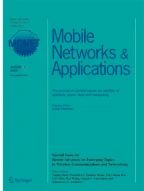Abstract
To enhance vehicular ad hoc networks (VANETs) with the ability to detect road conditions, hybrid VANET-sensor networks (HVSNs) additionally deploy a large number of wireless sensors on road sides, so as to provide a safer driving environment. Most of the previous works on network deployment problems considered too simplified problem settings, and few of them focused on deploying HVSNs. To meet more practical requirements, this paper investigates the problem of deploying roadside units (RSUs) to serve sensors on three different-dimensional road settings (i.e., a one-dimensional road, a road represented as grid points, and a dense network environment) in HVSNs with two objectives (i.e., to minimize the total distance and the total number of hops from sensors to their respective closest RSUs) and two QoS constraints (i.e., for maximal number of hops and capacity). Achieving the two objectives can effectively decrease the probability of transmission interference and lead to shorter transmission time to inform drivers of unexpected events. Since the optimal deployment problems for a grid road and a dense HVSN cannot be solved analytically, this paper creates mathematical programming models for the problems, and further proposes an improved harmony search algorithm. By simulation in different-size instances and statistical analysis, the proposed approaches show promising performance in solving the problems.
Similar content being viewed by others
Explore related subjects
Discover the latest articles, news and stories from top researchers in related subjects.References
Li P, Huang X, Fang Y, Lin P (2007) Optimal placement of gateways in vehicular networks. IEEE Trans Veh Technol 56(6):3421–3430
Wu TJ, Liao W, Chang CJ (2012) A cost-effective strategy for road-side unit placement in vehicular networks. IEEE Trans Commun 60(8):2295–2303
Lochert C, Scheuermann B, Wewetzer C, Luebke A, Mauve M (2008) Data aggregation and roadside unit placement for a VANET traffic information system. In: Proceedings of 5th ACM international workshop on vehicular Inter-NET working. pp. 58–65, ACM Press
Cavalcante ES, Aquino ALL, Pappa GL, Loureiro AAF (2012) Roadside unit deployment for information dissemination in a VANET: an evolutionary approach. In: Proceedings of GECCO’12. pp. 27–34, ACM Press
Liya X, Chuanhe H, Peng L, Junyu Z (2013) A randomized algorithm for roadside units placement in vehicular ad hoc network. In: Proceedings of MSN 2013, pp. 193–197, IEEE Press
Aslam B, Zou CC (2011) Optimal roadside units placement along highways. In: Proceedings of 2011 I.E. Consumer Communications and Networking Conference, pp. 814–815, IEEE Press
Ng SC, Zhang W, Zhang Y, Yang Y, Mao G (2011) Analysis of access and connectivity probabilities in vehicular relay networks. IEEE J Sel Areas Commun 29(1):140–150
Sou S, Tonguz OK (2011) Enhancing VANET connectivity through roadside units on highways. IEEE Trans Veh Technol 60(8):3586–3602
Patil P, Gokhale A (2012) Maximizing vehicular network connectivity through an effective placement of road side units using Voronoi diagrams. In: Proceedings of MDM 2012, pp. 274–275, IEEE Press
Hussain Rehman OM, Bourdoucen H, Ould-Khaoua M (2015) Forward link quality estimation in VANETs for sender-oriented alert messages broadcast. J Netw Comput Appl 58:23–41
Weingatner E, Kargl F (2007) A prototype study on hybrid sensor-vehicular networks technical report. RWTH-Aachen, Aachen
Qin R, Li Z, Wang Y, Lu X, Zhang WS (2010) An integrated network of roadside sensors and vehicles for driving safety: Concept, design and experiments. In: Proceedings of 2010 I.E. International Conference on Pervasive Computing and Communications, pp. 79–87, IEEE Press
Murthy GR, Piran MJ (2011) Instantaneous Accident Detection and Notification System, 3780/CHE/2011 A, November, 2011
Rebai M, Khoukhi L, Snoussi H, Hnaien F (2012) Optimal placement in hybrid VANETs-sensors networks. In: Proceedings of IEEE Wireless Advanced, pp. 54–57, IEEE Press
Ke WC, Liu BH, Tsai MJ (2011) The critical square grid coverage problem in wireless sensor networks is NP-complete. Comput Netw 55:2209–2220
Lin C, Deng D (2015) Optimal two-lane placement for hybrid VANET-sensor networks. IEEE Transactions on Industrial Electronics 62(12):7883–7891
Bejerano Y (2004) Efficient integration of multihop wireless and wired networks with QoS constraints. IEEE/ACM Trans Networking 12(6):215–226
Moussaoui A, Boukeream A (2015) A survey of routing protocols based on link-stability in mobile ad hoc networks. J Netw Comput Appl 47:1–10
Zheng J, Wu Y, Xu Z, Lin X (2014) A reliable routing protocol based on QoS for VANET. In: Proceedings of 2014 IEEE Conference on Advanced Infocomm Technology, pp. 21–28, IEEE Press
Aoun B, Boutaba R, Iraqi Y, Kenward G (2006) Gateway placement optimization in wireless mesh networks with QoS constraints. IEEE J Sel Areas Commun 24(11):2127–2136
Geem ZW, Kim JH (2001) A new heuristic optimization algorithm: harmony search. Simulation 76:60–68
Nezhad SE (2010) Solving k-coverage problem in wireless sensor networks using improved harmony search. In: Proceedings of IEEE Broadband, Wireless Computing, Communication and Applications, pp. 49–55, IEEE Press
Castelli M, Silva S, Manzoni L, Vanneschi L (2014) Geometric selective harmony search. Inf Sci 279:468–482
Li C, Wang L, Sun T, Yang S, Gan X, Yang F, Wang X (2014) Topology analysis of wireless sensor networks based on nodes’ spatial distribution. IEEE Trans Wirel Commun 13(5):2454–2453
Senouci MR, Mellouk A, Senouci H, Aissani A (2012) Performance evaluation of network lifetime spatial-temporal distribution for WSN routing protocols. J Netw Comput Appl 35:1317–1328
Acknowledgments
This work has been supported in part by MOST 104-2221-E-009-134-MY2, Taiwan.
Author information
Authors and Affiliations
Corresponding author
Additional information
An erratum to this article is available at http://dx.doi.org/10.1007/s11036-016-0698-4.
Rights and permissions
About this article
Cite this article
Lin, CC., Chen, PC. & Chang, LW. On Different-Dimensional Deployment Problems of Hybrid VANET-Sensor Networks with QoS Considerations. Mobile Netw Appl 22, 125–138 (2017). https://doi.org/10.1007/s11036-015-0667-3
Published:
Issue Date:
DOI: https://doi.org/10.1007/s11036-015-0667-3
